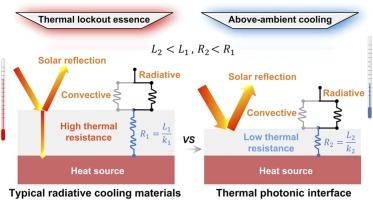极简集成,超薄,可扩展的热光学接口设计,用于环境上方冷却
IF 17.1
1区 材料科学
Q1 CHEMISTRY, PHYSICAL
引用次数: 0
摘要
辐射冷却(RC)在不消耗任何能量的情况下,利用其反射太阳光和向外太空被动热辐射的双重机制,具有巨大的节能和可持续发展潜力。然而,对于在室内和室外环境(例如,电子设备和通信基站)中具有大量自生热量并在高于环境温度的情况下工作的物体,RC仍然是一个基本挑战。为了解决这一限制,本研究通过热光学设计提出了一种集成的超薄热光子界面(TPI),该界面将具有高向后散射效率的二维六方氮化硼(h-BN)纳米板整合到聚合物/金属氧化物RC框架中。优化后的TPI具有优异的太阳反射率(>93%)和中红外发射率(96%)。在室内高热负荷下,涂有TPI的物体的温度分别比商用涂料和聚合物基体系统低11.5°C和13.2°C。此外,在夏季高热负荷的白天,TPI系统的温度比其他两个系统低5-8°C。值得注意的是,TPI在高于环境温度的情况下表现出出色的冷却性能。这项工作建立了一种可扩展的环境辐射冷却器设计策略,为将二维平面材料应用于RC应用提供了一种创新范例。本文章由计算机程序翻译,如有差异,请以英文原文为准。

Minimalist integrated, ultrathin, scalable design of thermo-optical interfaces for above-ambient cooling
Radiative cooling (RC) exhibits substantial potential for energy conservation and sustainable development, leveraging its dual mechanism of sunlight reflection and passive thermal emission to deep space without consuming any energy. However, RC remains a fundamental challenge for objects with substantial self-generated heat and operating above ambient temperature in both indoor and outdoor environments (e.g., electronic devices and communication base stations). To address this limitation, this work proposes an integrated and ultrathin thermal photonic interface (TPI) through thermo-optical design, which incorporates 2D hexagonal boron nitride (h-BN) nanoplates with high backward scattering efficiency into a polymer/metal oxide RC framework. The optimized TPI demonstrates exceptional solar reflectivity (>93%) and mid-infrared emissivity (96%). Indoors under high thermal loading, the object coated with the TPI demonstrates temperatures 11.5 °C and 13.2 °C lower than the commercial paint and polymer matrix systems, respectively. Additionally, under daytime with high thermal loading in summer, the TPI system maintains temperatures 5-8 °C below the other two. Notably, the TPI demonstrates excellent cooling performance above the ambient temperature. This work establishes a scalable design strategy for above-ambient radiative coolers, offering an innovative paradigm for implementing 2D planar materials to RC applications.
求助全文
通过发布文献求助,成功后即可免费获取论文全文。
去求助
来源期刊

Nano Energy
CHEMISTRY, PHYSICAL-NANOSCIENCE & NANOTECHNOLOGY
CiteScore
30.30
自引率
7.40%
发文量
1207
审稿时长
23 days
期刊介绍:
Nano Energy is a multidisciplinary, rapid-publication forum of original peer-reviewed contributions on the science and engineering of nanomaterials and nanodevices used in all forms of energy harvesting, conversion, storage, utilization and policy. Through its mixture of articles, reviews, communications, research news, and information on key developments, Nano Energy provides a comprehensive coverage of this exciting and dynamic field which joins nanoscience and nanotechnology with energy science. The journal is relevant to all those who are interested in nanomaterials solutions to the energy problem.
Nano Energy publishes original experimental and theoretical research on all aspects of energy-related research which utilizes nanomaterials and nanotechnology. Manuscripts of four types are considered: review articles which inform readers of the latest research and advances in energy science; rapid communications which feature exciting research breakthroughs in the field; full-length articles which report comprehensive research developments; and news and opinions which comment on topical issues or express views on the developments in related fields.
 求助内容:
求助内容: 应助结果提醒方式:
应助结果提醒方式:


